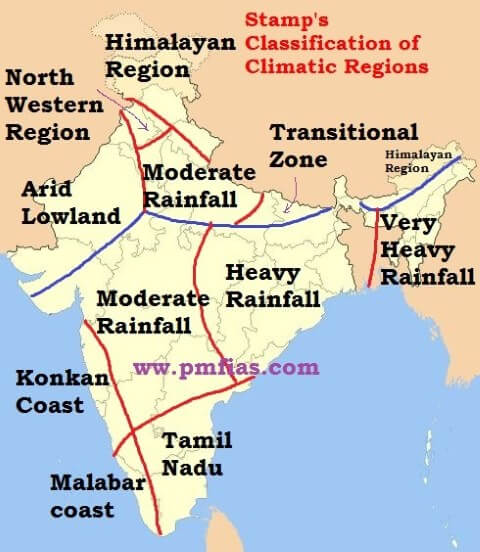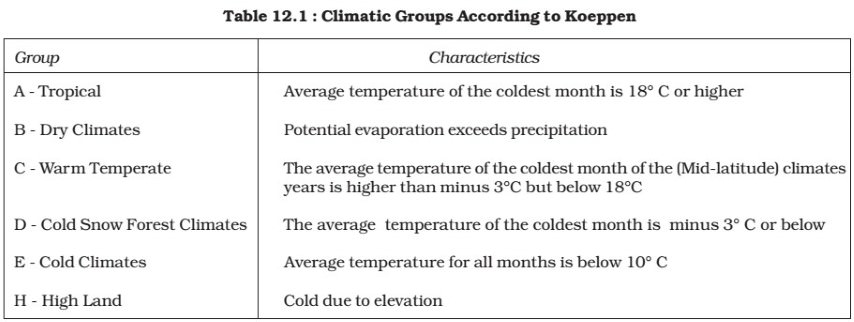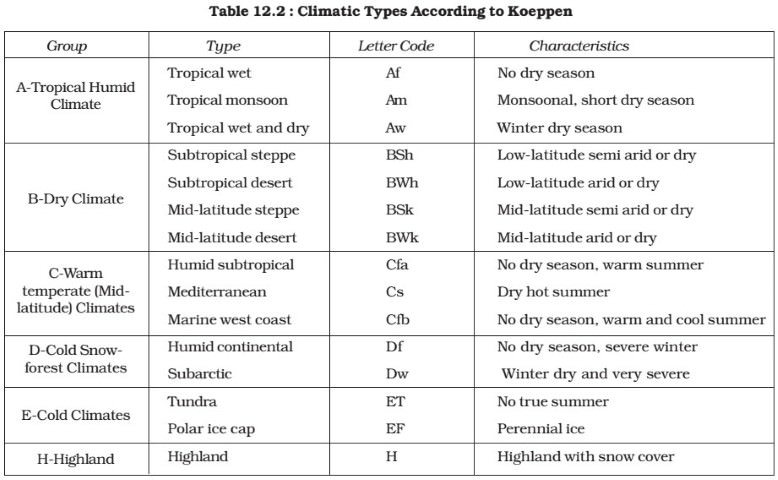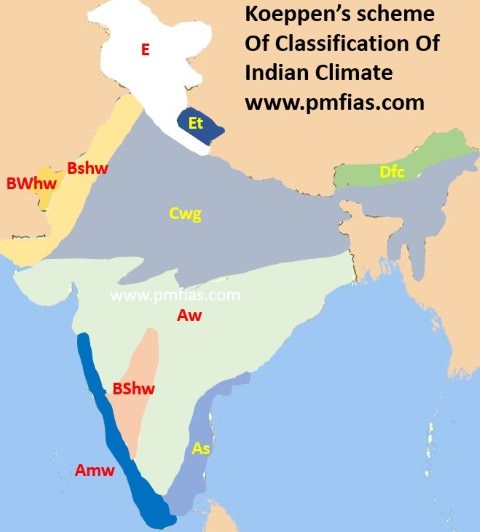Stamp’s & Koeppen’s Classification of Climatic Regions of India
Table of Contents
Climatic Regions of India – Stamp’s Classification of Climatic Regions of India: Temperate, Tropical – Koeppen’s Classification of Climatic Regions of India.
Climatic Regions of India
- India has tropical monsoon climate with large regional variations in terms of rainfall and temperature.
- While classifying Indian climatic regions, most geographers have given more importance to rainfall than to temperature as variations in rainfall are much more marked than those of temperature.
Here we will see two classifications – Stamp’s and Koeppen’s. For GS this is more than enough.
Stamp’s Classification of Climatic Regions of India
- Stamp used 18°C isotherm of mean monthly temperature for January to divide the country into two broad climatic regions, viz., temperate or continental zone in the north and tropical zone in the south.
- This line runs roughly across the root of the peninsula, more or less along or parallel to the Tropic of Cancer.
- The two major climatic regions are further divided into eleven regions depending upon the amount of rainfall and temperature.
Temperate or Continental India
- The Himalayan region (heavy rainfall)
- The north-western region (moderate rainfall)
- The arid low land
- The region of moderate rainfall
- The transitional zone
Tropical India
- Region of very heavy rainfall
- Region of heavy rainfall
- Region of moderate rainfall
- The Konkan Coast
- The Malabar Coast
- Tamil Nadu

Temperate or Continental India | ||
Region | Avg Temperature | Annual Rainfall |
| Himalayan Region | Sumer = 4°-7°C
Winter = 13°-18°C
| East = Over 200 cm
West = much less
|
| North-western Region
Northern parts of Punjab and southern parts of Jammu and Kashmir
| Summer = 16°C
Winter = 24°C
| Below 200 cm |
| Arid Lowland
Thar desert of Rajasthan, south western part of Haryana and Kachchh of Gujarat
| Winter = 16° to 24°C
Summer = 48°C
| Below 40 cm |
| Region of moderate rainfall
Punjab, Haryana, western Uttar Pradesh, Union Territory of Delhi, north-west Plateau area of Madhya Pradesh and eastern Rajasthan
| Winter = 15°-18°C
Summer = 33°-35°C
| 40 – 80 cm |
| Transitional Zone
Eastern Uttar Pradesh and Bihar
| Winter = 15°-19°C Summer = 30° – 35°C | 100 -150 cm |
Tropical India | ||
| Region of very heavy rainfall
Meghalaya, Assam, Tripura, Mizoram and Nagaland
| Winter = 18°C in Summer = 32°-35°C | Over 200 |
| Region of heavy rainfall
Chhattisgarh, Jharkhand, Gangetic West Bengal, Odisha and coastal Andhra Pradesh
| Winter = 18°-24°C
Summer = 29°-35°C
| 100 – 200 cm |
| Region of moderate rainfall
between Western and Eastern Ghats
| Winter = 18°-24°C Summer = 32°C in | 50 -100 cm |
| Konkan Coast
Mumbai in the north to Goa in the south
| Annual = 24°-27°C. | Over 200 cm |
| Malabar Coast
Goa to Kanniyakumari
| Annual = 27°C | Over 250 cm |
| Tamil Nadu
Tamil Nadu and adjoining areas of Andhra Pradesh
| Annual = 24°C | 100 to 150 cm
(Retreating monsoon)
|
Koeppen’s Classification of Climatic Regions of India
- Koeppen’s Classification of Climatic Regions of India is an empirical classification based on mean annual and mean monthly temperature and precipitation data.
- Koeppen identified a close relationship between the distribution of vegetation and climate.
- He selected certain values of temperature and precipitation and related them to the distribution of vegetation and used these values for classifying the climates.
- Koeppen recognized five major climatic groups, four of them are based on temperature and one on precipitation.
- The capital letters:
- A, C, D and E delineate humid climates and
- B dry climates.
[Don’t have to remember all these alphabets. Only remember the climatic regions and their characteristics. That’s enough
Alphabet codes will help you to remember the concept in the long run. But if you found them hard, just ignore them]
- The climatic groups are subdivided into types, designated by small letters, based on seasonality of precipitation and temperature characteristics.
- The seasons of dryness are indicated by the small letters : f, m, w and s, where
- f – no dry season,
- m – monsoon climate,
- w – winter dry season and
- s – summer dry season.
- The above mentioned major climatic types are further subdivided depending upon the seasonal distribution of rainfall or degree of dryness or cold.
a: hot summer, average temperature of the warmest month over 22°C
c: cool summer, average temperature of the warmest month under 22°C
f: no dry season
w: dry season in winter
s: dry season in summer
g: Ganges type of annual march of temperature; hottest month comes before the solstice and the summer rainy season.
h: average annual temperature under 18°C
m (monsoon): short dry season.
- The capital letters S and W are employed to designate the two subdivisions of dry climate:
- semi-arid or Steppe (S) and
- arid or desert (W).
- Capital letters T and F are similarly used to designate the two subdivisions of polar climate
- tundra (T) and
- icecap (F).



- Koeppen divided India into nine climatic regions making use of the above scheme.
Koeppen’s Scheme – Climatic Regions of India | ||
| Climate type | Region | Annual rainfall |
| Amw(Monsoon type with short dry winter season) | Western coastal region, south of Mumbai | over 300 cm |
| As(Monsoon type with dry season in high sun period) | Coromandel coast = Coastal Tamil Nadu and adjoining areas of Andhra Pradesh | 75 – 100 cm
[wet winters, dry summers]
|
| Aw(Tropical Savanah type) | Most parts of the peninsular plateau barring Coromandel and Malabar coastal strips | 75 cm |
| BShw(Semi-arid Steppe type) | Some rain shadow areas of Western Ghats, large part of Rajasthan and contiguous areas of Haryana and Gujarat | 12 to 25 cm |
| BWhw(Hot desert type) | Most of western Rajasthan | less than 12 cm |
| Cwg(Monsoon type with dry winters) | Most parts of the Ganga Plain, eastern Rajasthan, Assam and in Malwa Plateau | 100 – 200 cm |
| Dfc(Cold, Humid winters type with shorter summer) | Sikkim, Arunachal Pradesh and parts of Assam | ~200 cm |
| Et(Tundra Type) | Mountain areas of Uttarakhand
The average temperature varies from 0 to 10°C
| Rainfall varies from year to year. |
| E(Polar Type) | Higher areas of Jammu & Kashmir and Himachal Pradesh in which the temperature of the warmest month varies from 0° to 10°C | Precipitation occurs in the form of snow |
No comments:
Post a Comment